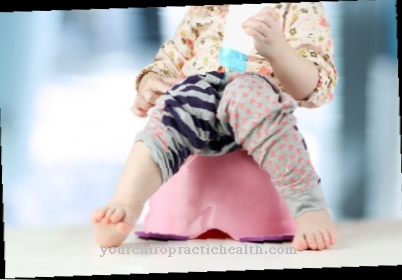The LEOPARD syndrome is closely related to Noonan's syndrome and is characterized by dermal and cardiac malformations that can be associated with symptoms such as numbness and retardation. The cause of the syndrome is a mutation in the PTPN11 gene. The treatment of those affected is symptomatic and focuses primarily on the heart defect.
What is LEOPARD Syndrome?

© pixtumz88 - stock.adobe.com
Malformation syndromes are repeated combinations of various malformations that are congenital and affect several tissues or organ systems. One of the most common malformation syndromes with a genetic basis is Noonan's syndrome, which is the second most common cause of congenital heart defects. In Germany, the syndrome affects an average of one newborn baby out of 1,000 births.
Closely related to the common Noonan syndrome, that is LEOPARD syndrome. Like Noonan's syndrome, LEOPARD syndrome is also associated with cardiac malformations, which are usually associated with cutaneous malformations as part of the disease. The term LEOPARD is an acronym for the typical clinical features of the malformation complex.
Lentiginosis, EKG changes, ocular abnormalities, pulmonary stenosis, anomalies in the genital area, retarded growth and deafness are summarized in the acronym as symptoms. In addition to the expressions, the terms are synonymous with the disease cardiocutaneous syndrome, cardiomyopathic lentiginosis and Lentiginosis Syndrome the names progressive cardiomyopathic lentiginosis and Capute-Rimoin-Konigsmark-Esterly-Richardson syndrome.
causes
As with Noonan's syndrome, the cause of LEOPARD syndrome lies in the genes. The cause of the disease is a genetic mutation. What both syndromes have in common is the categorization as hereditary disease with occasionally sporadic cases.
Familial accumulation could therefore be observed for the LEOPARD syndrome and in this case can be explained by the autosomal dominant inheritance. However, new mutations also occur, as they justify cases without a family history or inherited disposition. In most cases, the LEOPARD syndrome is preceded by a mutation in the PTPN11 gene.
This gene codes for a so-called non-receptor protein, the tyrosine phosphatase SHP-2. The mutation of the gene causes the protein to lose part of its function. Due to the mutation-related defects, the non-receptor protein tyrosine phosphatase SHP-2 has its catalytically intended activity. As a result, it only has an insufficient influence on certain growth or differentiation factors, which can be used to justify the symptoms of LEOPARD syndrome.
Symptoms, ailments & signs
Like any other malformation syndrome, LEOPARD syndrome is characterized by different symptoms. The main symptoms include lentiginosis, which means a multiple lens-shaped dermal macula. Conduction disorders such as bundle branch blocks occur in the patient as EKG changes.
Ocularly, there is hypertelorism in the sense of increased interpupillary distance. Pulmonary artery stenosis with possibly obstructive cardiomyopathy can also be symptomatic of the syndrome. In addition, anomalies in the genital area often occur, especially cryptorchidism or monoorchism. The musculoskeletal development of the patient is usually delayed. Deafness is another key symptom.
In addition to the main symptoms, there may be accompanying symptoms, especially neurological symptoms such as seizures or nystagism. Mental retardation was observed in the patient in isolated cases. The lentigines of the syndrome usually develop in childhood and often cover the entire surface of the body. With age, the changes in the face fade but remain in the oral cavity.
Diagnosis & course of disease
The first suspected diagnosis of LEOPARD syndrome is made on the basis of the clinical picture and anamnesis. Extensive, organ-specific examinations may be required to detect abnormalities such as a heart defect. In order to confirm the suspected diagnosis, similar malformation syndromes must be excluded in the context of the diagnosis in a differential diagnostic manner.
A molecular genetic examination can finally confirm the suspected diagnosis. The prognosis for patients with LEOPARD syndrome depends on the symptoms, their severity and treatability in the individual case. The life expectancy of the patient is usually not affected.
Complications
With the LEOPARD syndrome, those affected suffer from various complaints and symptoms. However, these complaints are very serious and can significantly reduce the quality of life of the person affected. This usually results in numbness and possibly also eye discomfort. Especially in children, these restrictions can lead to severe delays in the development of the person concerned.
Furthermore, various malformations occur all over the body, so that in most cases the patients are dependent on the help of other people in their everyday lives. Mental retardation also occurs due to the LEOPARD syndrome. It is not uncommon for the relatives or parents of the affected children to suffer from psychological complaints and depression.
The syndrome can also lead to a heart defect and significantly reduce the patient's life expectancy. Seizures can also occur and be associated with pain. Various changes occur on the face that can lead to bullying or teasing in the patient.
A causal treatment of the LEOPARD syndrome is not possible. Those affected are dependent on various therapies that alleviate the symptoms. There are no further complications, but the course of the disease is not completely positive.
When should you go to the doctor?
LEOPARD syndrome is often diagnosed immediately after birth. Whether further medical treatment is necessary depends on the severity of the malformations and accompanying symptoms. Basically, anomalies in the genital area as well as muscular disorders must be treated. The parents should discuss this with the responsible doctor and then initiate suitable measures. If complications arise in the course of the disease, such as seizures or serious skin changes, the doctor must be informed.
If an accident occurs as a result of a seizure, the emergency medical service is the appropriate contact point for parents. In addition to the general practitioner, an orthopedist, urologist, gynecologist, neurologist and / or dermatologist must be involved depending on the symptom complex. Misalignments and bad posture are treated by a physiotherapist. The LEOPARD syndrome is often linked to emotional complaints that require therapeutic treatment. The therapy of the physical complaints lasts for several months to years, whereby the individual symptoms have to be treated for a lifetime even with early treatment.
Treatment & Therapy
A causal therapy to correct the cause of the LEOPARD syndrome is not yet available. Since the symptoms of malformation syndrome can be traced back to a genetic defect, advances in gene therapy over the next few decades could open up causal treatment options. So far, gene therapy approaches have not reached the clinical phase.
For this reason, patients with malformation syndrome have so far been treated symptomatically and supportively. Depending on the symptoms present in the individual case, the treating doctor prioritizes, for example, the treatment of vital organs. If there is a heart defect, invasive treatment is usually given.
After the corrective operation, conservative drug therapy steps may be necessary. Apart from the cardiac defects, most malformations in the context of the LEOPARD syndrome do not require any therapeutic intervention. Monitoring and regular check-ups for lentiginosis are usually not required.
Studies have shown that there is no increased tendency to degenerate for the dermal changes. So the patients do not have to expect a higher cancer risk. In individual cases, measures such as physiotherapy or early intervention can be used to counteract the mental and, in some cases, motor development delays.
The common numbness of patients can also be treated moderately. The provision of hearing aids may be an option under certain conditions. For unsuitable patients, an early introduction to sign language is helpful in order to give them unlimited freedom of expression.
You can find your medication here
➔ Medicines for painOutlook & forecast
Although the patient's life expectancy is not necessarily restricted in the case of leopard syndrome, symptoms can arise in the course of the disease that can severely reduce the quality of life. Numbness is possible, as well as discomfort to the eyes. In young patients, these restrictions can also lead to a delayed development of the person concerned. Malformations on the patient's body are also possible, which in the further course can make the person affected dependent on constant help in everyday life. Mental impairments have also been observed, but these do not occur regularly.
It is recommended, especially in the case of juvenile patients, to offer psychological support to the parents of those affected, because it is not uncommon for the relatives of the children to suffer greatly from the course of the disease, so that depression or psychological complaints may arise. Heart defects can also occur in the course of the disease. Seizures associated with pain are possible and should be treated separately. Changes in the patient's face can be another problem. Teasing or "mobbing" by the social environment may also occur here as a psychological aspect.
A causal treatment of leopard syndrome is currently not possible. Various forms of therapy provide relief and, in some cases, improvement for those affected, but according to the current state of medicine, a cure is not possible. Even if further complications can be ruled out in the course of therapy, one cannot generally speak of a positive course of the disease.
prevention
Since the LEOPARD syndrome is a genetically caused malformation syndrome, the phenomenon can only be prevented to a limited extent so far. In the broadest sense, for example, genetic counseling in the family planning phase can be viewed as a preventive step. Due to the possibility of a new mutation, the disease cannot be completely ruled out for a planned child despite genetic advice.
Aftercare
In the case of LEOPARD syndrome, the person affected usually has very few or even no special measures and options for follow-up care available. First and foremost, early detection is very important so that the symptoms do not deteriorate further. As a rule, the earlier a doctor is contacted, the better the further course.
Since the LEOPARD syndrome is a hereditary disease, a genetic examination and counseling should always be carried out if the child wishes to have children in order to prevent the disease from recurring in the descendants. As a rule, patients with LEOPARD syndrome are dependent on various surgical interventions to alleviate the symptoms and remove the tumors.
After such an operation, the person concerned should definitely rest and take care of his body. Exertion or physical activity should be avoided. Furthermore, many patients are also dependent on the help of other people in their everyday life. Above all, the help and care provided by one's own family has a very positive effect on the course of the LEOPARD syndrome and can possibly also prevent depression or other psychological upsets.
You can do that yourself
The measures for self-help and for alleviating the symptoms are very limited for patients. However, symptoms can be relieved in some cases.
Since it is a hereditary disease, genetic counseling is very advisable for those affected and their parents. This can prevent the syndrome from occurring in future generations. The motor and mental delays in this syndrome are treated by means of physiotherapy and intensive support. The exercises from physiotherapy can often be performed in your own home, which also speeds up the therapy.
Furthermore, the parents and relatives should always encourage the child to compensate for the intellectual complaints. Above all, early support has a very positive effect on the further course of these complaints. In the case of deafness, those affected should always wear a hearing aid, since without a hearing aid, the ears can be further damaged by loud noises. As a rule, this also promotes the child's development, as the child can take part in conversations. In addition, it is often worth making contact with other people affected by the LEOPARD syndrome, as this can lead to an exchange of information.

.jpg)


.jpg)
.jpg)
.jpg)





















